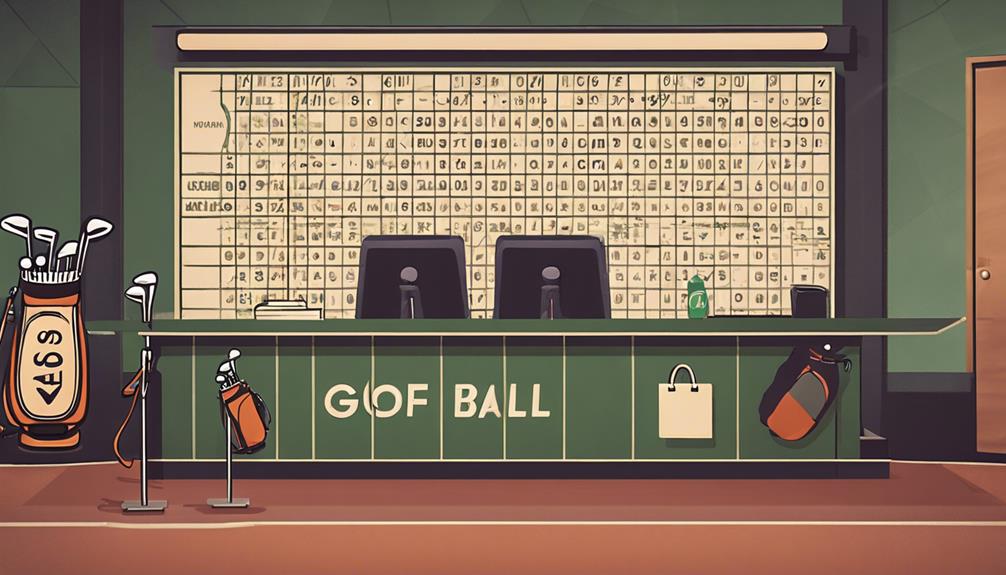- 7 Top Flite Golf Clubs XL for Improved Performance - September 28, 2024
- Top Flite Golf Clubs: Top 5 Reasons to Choose Them - September 28, 2024
- Top 3 Golf Club Fitters for a Perfect Swing - September 28, 2024
As a golf club operator, you face a complex VAT landscape, where rates vary considerably across European countries, with Denmark imposing a 25% VAT rate on commercial courses and the Netherlands offering a lower 6% rate. Understanding these discrepancies is vital to optimize VAT recovery and guarantee compliance. You'll need to navigate VAT registration, input tax, and output tax calculations, as well as manage exempt supplies, membership fees, and room hire. With VAT implications affecting your growth and development, it's important to grasp these concepts to stay competitive – and there's more to explore when it comes to revealing the full potential of your golf club.
Key Takeaways
- Register for VAT if taxable turnover exceeds £85,000; separate registration required for independent sections or branches.
- Accurately apportion VAT on membership fees and subscriptions, considering specific benefits and exempt supplies.
- Maintain meticulous records of VAT transactions, separating business and non-business activities for input tax reclaim and compliance.
- Understand VAT implications when raising capital from members through loans, levies, shares, or debentures, and accurately account for VAT.
Understanding VAT Rates
When operating a golf club in Europe, you face a complex landscape of VAT rates that vary considerably from country to country.
As a golf club owner or manager, it's crucial to understand these rates to guarantee compliance and optimize your financial strategy. In Denmark, for instance, you'll face a 25% VAT rate for commercial courses, while non-commercial clubs are exempt. In the Netherlands, golf course owners enjoy a lower 6% VAT rate, creating disparities in competition between commercial and non-commercial clubs.
As you navigate this VAT landscape, you'll need to reflect on how these rates impact your pricing and services. High VAT rates on commercial clubs can hinder their ability to promote the sport and provide training to new golfers. On the other hand, VAT exemptions may apply to certain non-profit organizations, affecting how you structure your pricing and services.
This guide will serve as your thorough resource, helping you understand the intricacies of VAT rates and their implications for your golf club. By grasping these VAT rates, you'll be better equipped to make informed decisions and optimize your club's financial performance.
VAT Impact on Golf Development
As you examine the impact of VAT on golf development, you'll notice that the disparity in VAT rates has far-reaching consequences.
It hinders the growth of commercial golf clubs, which are essential for teaching new golfers, and creates an uneven playing field that discourages investments in facilities.
This, in turn, affects the overall development of the sport, limiting its accessibility and popularity.
VAT Disparity Effects
High VAT rates imposed on commercial golf clubs, such as Denmark's 25%, frequently hinder their ability to promote the sport effectively and attract new players.
As you navigate the rules of VAT for golf, it's vital to understand how these rates impact the competitive environment. The disparity in VAT rates allows non-commercial clubs to undercut commercial clubs, creating an uneven competitive landscape. This means you'll face stiffer competition from non-commercial clubs that don't bear the same VAT burden.
Additionally, commercial clubs often bear the responsibility of teaching new golfers, and high VAT rates limit their resources for such initiatives. The Golf Club Alliance for Europe (GCAE) highlights that VAT discrepancies discourage investment in commercial golf facilities, stunting growth.
Efforts to equalize VAT levels across the EU aim to create a fairer competitive environment, which is fundamental for the overall development and accessibility of golf. By understanding the VAT disparity effects, you can better navigate the challenges and opportunities in the golf industry.
Golf Development Hindrance
Twenty-five percent VAT rates, like those in Denmark, severely curtail your ability to promote and grow the sport, as operational costs skyrocket. This significant burden hinders your capacity to invest in facilities, programs, and services that attract new players and foster a love for the game.
The increased expenses trickle down to the consumer, making golf less accessible to a broader audience. As a result, you're forced to allocate resources inefficiently, diverting funds from development initiatives to cover VAT costs.
This VAT impact on golf development is a significant obstacle to growing the sport. The basic rules of VAT should guide your understanding of the issue, but it's crucial to recognize the disparities in VAT treatment among different types of golf clubs.
Non-commercial clubs, exempt from VAT, have a distinct advantage over commercial clubs, which are subject to VAT on goods and services. This uneven playing field stifles investment in commercial facilities and programs, ultimately affecting the overall growth and accessibility of golf.
As you navigate the complexities of VAT, this guide will help you understand the implications of VAT on golf development and the need for reform to create a fairer competitive environment.
Competitive Imbalance
You face a significant challenge when competing with non-commercial golf clubs, which enjoy a distinct financial advantage due to their VAT-exempt status. This disparity creates a competitive imbalance, making it difficult for commercial clubs like yours to remain viable.
Here are three key ways in which VAT rates affect your competitiveness:
- Pricing pressure: With high VAT rates, you're forced to increase prices, making your services less attractive to customers. Non-commercial clubs, on the other hand, can offer lower prices and still maintain a healthy profit margin.
- Investment constraints: The elevated VAT burden limits your ability to invest in essential programs and facilities, such as junior golf development initiatives or course improvements. This hinders your ability to attract and retain members.
The competitive imbalance created by VAT rates undermines the viability of commercial golf clubs, ultimately affecting the sport's growth and accessibility.
GCAE Initiatives for Reform

You're now examining the GCAE's efforts to reform the VAT system, which is vital for creating a level playing field for commercial golf clubs.
Through its collaboration with the English Golf Union, the GCAE has established a working group to tackle VAT policy reform, aiming to eliminate unfair tax burdens.
GCAE Collaboration
Through its collaborative efforts with the English Golf Union, the GCAE has made significant strides in addressing the VAT issues that have long plagued the golf industry, ultimately promoting fair competition among clubs.
As you navigate the complex landscape of VAT regulations, it's crucial to understand the GCAE's collaborative initiatives.
Here are three key aspects of the GCAE's collaboration:
- Establishing a working group: The GCAE has set up a working group focused on equalizing VAT levels across the EU for golf course owners, guaranteeing a level playing field for all clubs.
- Advocating for VAT reforms: The GCAE advocates for reforms to eliminate unfair tax burdens imposed by varying VAT rates, which create competitive imbalances among clubs.
VAT Policy Reform
The GCAE's VAT policy reform initiatives focus on eliminating discriminatory tax practices that hinder the growth of the golf industry, thereby promoting a more competitive and sustainable business environment. As you navigate the complex landscape of VAT regulations, it is crucial to understand the GCAE's efforts to create a level playing field for golf clubs across Europe.
| Initiative | Objective |
|---|---|
| Advocating for equalized VAT levels | Create a fair competitive environment for golf course owners |
| Launching a working group | Foster cooperation among golf clubs to tackle VAT policy discrepancies |
| Submitting recommendations during public consultations | Reform VAT policies for the golf industry |
| Educating and raising awareness | Highlight the negative impact of high VAT rates on commercial golf clubs |
| Collaborating with the English Golf Union | Address VAT issues affecting golf clubs across Europe |
Working Group Launch
As the GCAE continues to advocate for VAT policy reform, its latest initiative takes a significant step forward with the launch of a working group dedicated to tackling VAT discrepancies affecting golf course owners across Europe. This working group is a pivotal move towards creating a fair and competitive environment in the golf industry.
The working group's primary objectives are:
- Collaborate with the English Golf Union to push for equalization of VAT rates for commercial and non-commercial golf clubs.
- Eliminate VAT rate discrepancies that create unfair competitive advantages for certain golf clubs.
EU VAT System Reform Efforts
Recognizing the need to simplify and streamline the EU VAT system, you'll find that the Council has thrown its weight behind initiatives aimed at tackling the existing complexities that have long plagued this area. The European Commission took a significant step in this direction by adopting a Green Paper on VAT in December 2010, which sparked a public consultation that garnered a record 1726 responses. This move underscored the urgency for VAT reform, a sentiment echoed by the European Parliament and the European Economic and Social Committee (EESC).
| Stakeholder | Role in VAT Reform |
|---|---|
| European Commission | Adopted Green Paper on VAT, initiated public consultation |
| European Parliament | Confirmed necessity for VAT reform to improve competitiveness and compliance |
| EESC | Confirmed necessity for VAT reform to improve competitiveness and compliance |
As a golf club owner, you're likely aware of the GCAE's efforts to advocate for equalized VAT levels across EU member states, in collaboration with the English Golf Union. Public consultations are also seeking input on reduced VAT rates and policies that encourage consumption, aiming to create a fair competitive environment for all clubs. By staying informed about these developments, you'll be better equipped to navigate the complex world of VAT and guarantee your golf club remains competitive in the EU market.
VAT Registration for Golf Clubs

You must register for VAT if your golf club's business activities exceed the VAT threshold, currently set at £85,000 in taxable turnover. This includes activities that provide benefits to members in exchange for membership subscriptions or making supplies to non-members for a charge.
Here are some key considerations for VAT registration:
- Separate registration for sections, branches, and sub-clubs: If these operate independently and meet the registration criteria, they may require separate VAT registration.
- Commercial services and catering facilities: Guarantee compliance with VAT registration and reporting obligations if your club provides these services.
Input Tax and Apportionment
Golf clubs can reclaim input tax on purchases of goods and services used for business purposes, but they must navigate the complexities of apportioning VAT on mixed-use items and exempt supplies. As you're aware, input tax is the VAT charged on these purchases, which can be reclaimed under certain conditions.
However, VAT incurred on non-business activities, such as free admission to premises, can't be reclaimed as input tax.
When goods and services are used partly for business and partly for non-business purposes, you must apportion the VAT accordingly. This is where the Lennartz Accounting method comes in handy, allowing you to reclaim VAT on goods that are used for both business and private purposes by establishing a proportional claim process.
Be mindful that input tax related to exempt supplies, such as certain membership benefits, typically can't be deducted, affecting overall VAT recovery for golf clubs.
Accurate apportionment is essential to guarantee you're not overpaying or underpaying VAT. By understanding the intricacies of input tax and apportionment, you can optimize your VAT recovery and minimize potential errors.
Output Tax and Subscriptions

When calculating output tax, you'll need to determine the VAT due on your golf club's standard-rated and reduced-rated supplies.
As you account for output tax, you'll apply the VAT fraction to your transactions, guaranteeing accurate VAT obligations.
Now, let's focus on output tax calculations, particularly in relation to VAT on membership fees, to guarantee you're meeting your VAT liabilities.
Output Tax Calculations
Calculating output tax on subscriptions requires careful evaluation of the benefits provided to members, as the VAT liability depends on the specific supplies included in the subscription package.
You need to identify the standard-rated, reduced-rated, and exempt supplies within the subscription to determine the correct output tax.
Here are the key factors to examine for accurate output tax calculations:
- Apportionment of output tax: When subscriptions include exempt supplies, you must apportion the output tax accordingly to determine the correct VAT liability.
- VAT fraction application: You must apply the VAT fraction to the total value of the subscription to calculate the output tax due.
VAT on Membership Fees
Determining the VAT liability on membership fees requires a thorough understanding of the benefits provided, as the entire fee is subject to VAT based on the nature of these benefits.
You need to identify the specific benefits included in the membership subscription to determine the VAT treatment. If the subscription includes exempt supplies, such as access to a golf course, you may need to apportion the fee using the VAT fraction. This calculation is essential to guarantee accurate VAT accounting.
When apportioning the fee, you'll need to separate the taxable and exempt supplies. For instance, if the subscription includes both golf course access and access to a taxable restaurant, you'll need to allocate the fee accordingly. Additional joining fees are treated similarly, requiring apportionment if they include exempt benefits.
Non-profit organizations should also consider special VAT treatment for subscriptions, which may allow for apportionment under certain circumstances. By accurately determining the VAT liability on membership fees, you can guarantee compliance with VAT regulations and avoid potential penalties.
VAT on Golf Club Subscriptions
You need to contemplate the benefits provided to members to determine the VAT liability of your golf club subscriptions. As a general rule, subscriptions are treated as a single supply for VAT purposes, and the VAT liability depends on the benefits provided to members.
When it comes to VAT on golf club subscriptions, you should consider the following:
- Exempt supplies: If a subscription includes exempt supplies, it may require apportionment to determine the taxable portion of the total subscription fee.
- Additional joining fees: These are treated similarly to subscriptions, applying the same VAT rules and potential apportionment.
It's vital to accurately determine the VAT liability of your golf club subscriptions to guarantee compliance with VAT regulations.
Non-profit making bodies may apportion subscriptions under an extra statutory concession if they provide a mix of taxable and exempt benefits.
Raising Capital From Members

When raising capital from members through loans, levies, shares, or debentures, golf clubs must carefully consider the VAT implications of these transactions to avoid unexpected tax liabilities. You must determine whether these transactions are considered additional consideration for membership benefits, which would require accurate VAT accounting.
Any fees associated with raising capital, such as joining fees or additional contributions, may be treated similarly to subscriptions and may necessitate apportionment for VAT purposes. As you collect funds from members, guarantee compliance with VAT regulations to avoid unexpected tax liabilities.
The treatment of capital raised from members can impact your overall VAT liability, particularly if it involves exempt supplies. Accurate records must be maintained regarding any capital raised from members to guarantee transparency and compliance during VAT inspections.
VAT on Hire of Rooms and Halls
Golf clubs must understand the VAT implications of hiring out rooms and halls, as the tax treatment depends on whether the building has been opted for taxation and the specific services included in the arrangement. As a golf club, you need to determine the VAT treatment of your room and hall hire transactions to guarantee compliance.
Here are the key points to reflect on:
- Exemption: If the building hasn't been opted for taxation, the hire of a room or hall for exclusive occupation is generally exempt from VAT, as long as the provision includes lighting and furniture as part of the arrangement.
- VAT Application: If you opt the building for taxation, standard VAT rates may apply to the hire of rooms and halls.
Exempt Supplies by Golf Clubs

Exempt supplies, a significant aspect of VAT for golf clubs, encompass entry fees for competitions and specific benefits provided to members, provided they meet stringent criteria.
As you navigate VAT for your golf club, it's important to understand what constitutes exempt supplies. Typically, these include entry fees for competitions and certain benefits provided to members, which may not incur VAT if they meet specific criteria.
Your membership subscriptions can also be treated as exempt supplies if they primarily offer benefits that are also exempt from VAT. However, you'll need to apportion the subscription correctly when other taxable benefits are included.
Be aware that providing additional services, such as catering or facility hire, requires careful assessment of their VAT status to determine if they fall under exempt categories.
Managing VAT Records and Compliance
You must maintain meticulous VAT records to confirm compliance with regulations, accurately documenting all taxable and exempt supplies made by your golf club. This involves separating business and non-business activities, as you can only reclaim input tax on business purchases. Apportionment methods, outlined in VAT Notice 700, help allocate VAT between these activities.
To confirm compliance, follow these essential steps:
- Regularly file VAT returns: Submit returns by the deadline dictated by your VAT accounting scheme to avoid penalties.
- Maintain detailed records: Keep thorough records of all VAT transactions to facilitate inspections by VAT assurance staff and prevent disputes.
Frequently Asked Questions
Do You Pay VAT on a Round of Golf?
When you play a round of golf, you'll likely pay VAT, but it depends on the club type and services provided. Check if your golf membership fees include VAT, as some clubs exempt certain services or fees, making them non-taxable.
Conclusion
As you navigate the complexities of VAT for golf clubs, remember that the green isn't always as smooth as it seems.
With each shot, you must consider the rules and regulations that govern your club's financial landscape.
By following this guide, you've taken a significant step towards mastering the VAT landscape, just like a pro teeing off at the Masters.
Now, it's time to putt your knowledge into practice and guarantee your club's financial future is par for the course.




